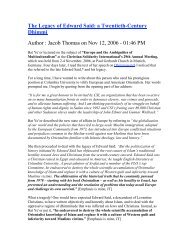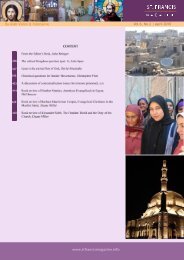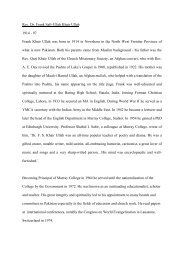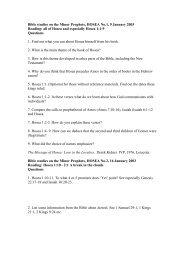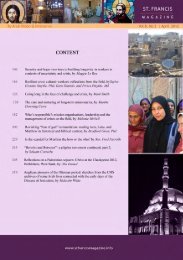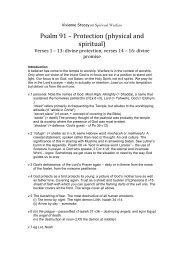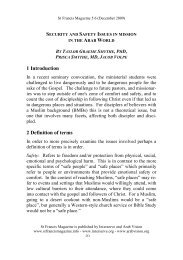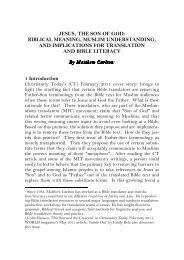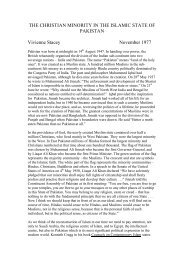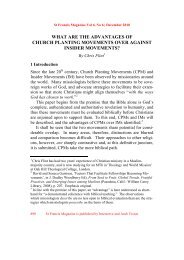download the pdf - St.Francis Magazine
download the pdf - St.Francis Magazine
download the pdf - St.Francis Magazine
Create successful ePaper yourself
Turn your PDF publications into a flip-book with our unique Google optimized e-Paper software.
<strong>St</strong> <strong>Francis</strong> <strong>Magazine</strong> Vol 8, No 4 | August 2012<br />
Since <strong>the</strong>n, o<strong>the</strong>rs have highlighted that this spectrum was already<br />
subject to discussion and refinement amongst missiologists and<br />
practitioners of mission, suggesting that its ultimate origins lie in<br />
West Java, around 1990 (Dixon 2009: 40). Fur<strong>the</strong>rmore, “By <strong>the</strong><br />
late 1970s, all <strong>the</strong> positions along what may now be described as <strong>the</strong><br />
C-scale had been articulated in seminal articles,” (Travis and Travis<br />
2008: 194n122; cf. Schlorff 2006: 79-89) 9 and Schlorff (2006: 9-10,<br />
14-17) identifies precursors to C5 in <strong>the</strong> 1920s. Likewise, <strong>the</strong> concept<br />
of insider movements was already in circulation in 1985, although<br />
nothing was published at that time (Brown, in Corwin et al.<br />
2007: 7), and it has precedents earlier in mission history (Higgins, in<br />
Corwin et al. 2007: 7). O<strong>the</strong>rs have seen precursors to it in new<br />
‘Christian’ villages formed by MBBs in nineteenth-century Java<br />
(Tee 2007: 5 cf. Asad 2009b: 142-149). Never<strong>the</strong>less, Travis<br />
(1998a) brought <strong>the</strong> matter to publication and, thus, into visible and<br />
formal debate.<br />
The debate got off to an immediate and lively start. In <strong>the</strong> same<br />
issue of Evangelical Missions Quarterly [EMQ] that published Travis’<br />
initial article, Phil Parshall – an earlier pioneer and advocate for C4<br />
ministries – issued several warnings concerning C5 as a missionary<br />
strategy, thus demarcating some of <strong>the</strong> ensuing discussions (Parshall<br />
1998b). First, while allowing for C5 as a transitional stage<br />
towards C4, Parshall feared C5 also risked forming a slippery slope<br />
towards syncretism and, also, that it was open to charges of deception.<br />
In many ways Parshall’s comments were moderate, but <strong>the</strong>y<br />
sparked fur<strong>the</strong>r questioning and reiteration of C5 as a missionary<br />
methodology, which was not Travis’ intention. Travis (1998b: 412-<br />
413) subsequently distanced himself from Parshall’s suggestion that<br />
C5 ministries included conversion (or reconversion) to official Islam,<br />
something which Parshall saw as “high syncretism... regardless of<br />
motivation” (Parshall 1998b: 405; ellipsis original), thus largely<br />
sharing Parshall’s rejection of Christians becoming Muslims to<br />
9 Cf. Travis and Travis (2008: 203n136): “The earliest articles alluding to <strong>the</strong> need<br />
for a C5 orientation came from Anderson (1976), Wilder (1977), Kraft (1979), and<br />
Conn (1979).”<br />
<strong>St</strong> <strong>Francis</strong> <strong>Magazine</strong> is a publication of Interserve and Arab Vision 456




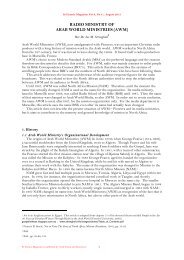
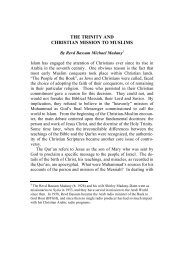
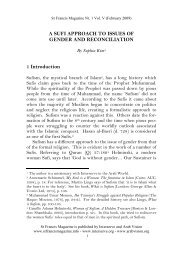
![Reflections on Surah Fatiha and the Lord's Prayer[1] - St.Francis ...](https://img.yumpu.com/49377951/1/184x260/reflections-on-surah-fatiha-and-the-lords-prayer1-stfrancis-.jpg?quality=85)
